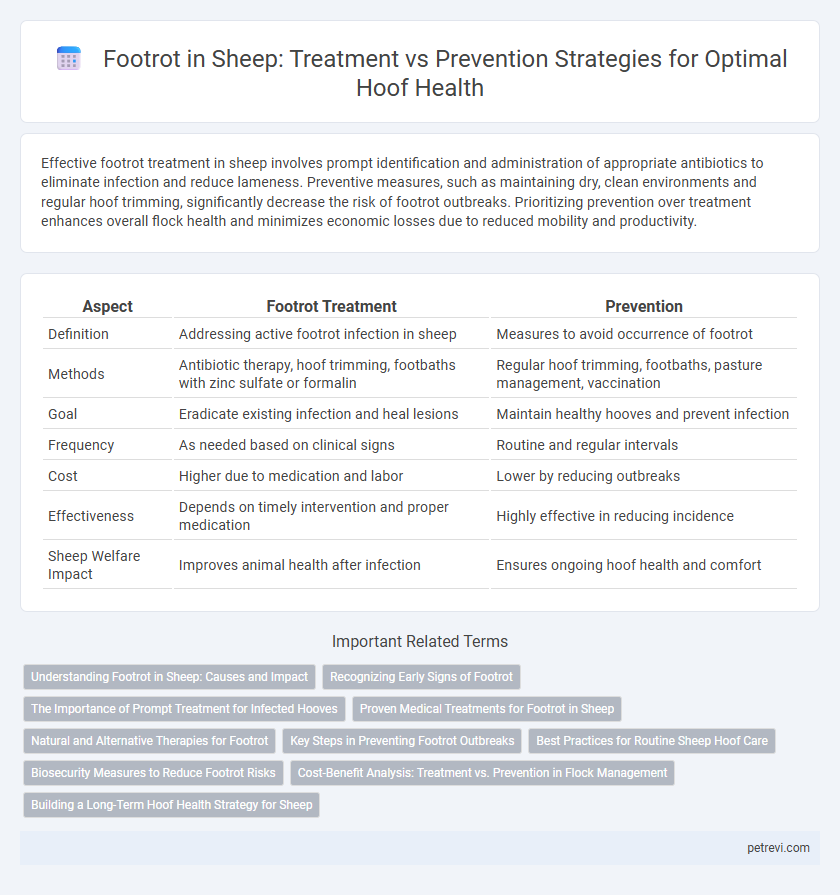Effective footrot treatment in sheep involves prompt identification and administration of appropriate antibiotics to eliminate infection and reduce lameness. Preventive measures, such as maintaining dry, clean environments and regular hoof trimming, significantly decrease the risk of footrot outbreaks. Prioritizing prevention over treatment enhances overall flock health and minimizes economic losses due to reduced mobility and productivity.
Table of Comparison
| Aspect | Footrot Treatment | Prevention |
|---|---|---|
| Definition | Addressing active footrot infection in sheep | Measures to avoid occurrence of footrot |
| Methods | Antibiotic therapy, hoof trimming, footbaths with zinc sulfate or formalin | Regular hoof trimming, footbaths, pasture management, vaccination |
| Goal | Eradicate existing infection and heal lesions | Maintain healthy hooves and prevent infection |
| Frequency | As needed based on clinical signs | Routine and regular intervals |
| Cost | Higher due to medication and labor | Lower by reducing outbreaks |
| Effectiveness | Depends on timely intervention and proper medication | Highly effective in reducing incidence |
| Sheep Welfare Impact | Improves animal health after infection | Ensures ongoing hoof health and comfort |
Understanding Footrot in Sheep: Causes and Impact
Footrot in sheep is primarily caused by the bacteria Dichelobacter nodosus and Fusobacterium necrophorum, thriving in wet and unsanitary conditions that damage the hoof tissue. Effective footrot treatment involves prompt use of antibiotics and hoof trimming, but prevention through proper pasture management and regular hoof inspections significantly reduces incidence rates. Understanding the environmental factors and early symptoms is crucial for maintaining flock health and minimizing economic losses from lameness.
Recognizing Early Signs of Footrot
Recognizing early signs of footrot in sheep, such as lameness, redness, swelling, and foul odor between the hooves, is crucial for effective treatment and prevention. Prompt intervention with topical antibiotics and proper hoof trimming can halt the progression of infection and reduce flock-wide outbreaks. Consistent monitoring and maintaining dry, clean living conditions significantly prevent the onset of footrot and promote overall hoof health in sheep.
The Importance of Prompt Treatment for Infected Hooves
Prompt treatment of footrot in sheep is critical to prevent the spread of infection and reduce lameness, which can severely impact flock productivity. Immediate intervention using appropriate antibiotics and hoof trimming minimizes tissue damage and accelerates healing, limiting economic losses. Consistent monitoring and early detection are essential for effective footrot management and maintaining overall flock health.
Proven Medical Treatments for Footrot in Sheep
Effective footrot treatment in sheep primarily involves the use of antibiotics such as oxytetracycline or long-acting tetracyclines, which target the bacterial infection caused by Dichelobacter nodosus. Proper footbath protocols utilizing zinc sulfate or formalin solutions complement systemic antibiotic therapy by reducing bacterial load and preventing reinfection. Regular monitoring and prompt medical intervention remain crucial to mitigating lameness and ensuring quicker recovery in affected flocks.
Natural and Alternative Therapies for Footrot
Footrot in sheep can be managed effectively through natural and alternative therapies such as herbal footbaths using neem or tea tree oil, which exhibit antimicrobial properties that reduce infection and promote healing. Preventative measures focusing on maintaining clean, dry environments and regular hoof trimming help minimize the risk of footrot development while supporting natural hoof health. Incorporating probiotics and essential oils into sheep diets or topical treatments enhances immune response and accelerates recovery without relying on conventional antibiotics.
Key Steps in Preventing Footrot Outbreaks
Effective footrot prevention in sheep involves maintaining dry living conditions, regular hoof inspections, and prompt removal of infected material to reduce bacterial buildup. Vaccination against Dichelobacter nodosus enhances flock immunity, while footbathing with zinc sulfate or copper sulfate solutions inhibits pathogen spread. Implementing quarantine measures for new or affected sheep and ensuring good nutrition further boost hoof health and resilience against footrot outbreaks.
Best Practices for Routine Sheep Hoof Care
Effective sheep hoof care prioritizes prevention methods such as regular hoof trimming, maintaining dry and clean environments, and providing foot baths with appropriate antimicrobial solutions to reduce the risk of footrot infections. Early detection of lameness and prompt treatment with topical antibiotics or systemic therapy can minimize damage and improve recovery rates. Implementing a routine hoof care program combining these practices enhances flock health and productivity by reducing the incidence of footrot.
Biosecurity Measures to Reduce Footrot Risks
Effective footrot treatment in sheep involves targeted antibiotic therapy and regular hoof trimming, but prevention through stringent biosecurity measures offers longer-term benefits. Implementing quarantine protocols for new or returning animals, maintaining dry and clean bedding, and minimizing flock mixing significantly reduce the introduction and spread of Dichelobacter nodosus, the primary bacterial agent. Consistent biosecurity practices cut infection rates, lower treatment costs, and promote overall flock health by creating an unfavorable environment for footrot development.
Cost-Benefit Analysis: Treatment vs. Prevention in Flock Management
Effective footrot treatment in sheep often involves antibiotics and labor-intensive hoof trimming, incurring higher immediate costs and increased labor demands. Preventive measures like regular hoof inspections, vaccination, and maintaining dry conditions require upfront investment but reduce long-term expenses and flock morbidity. Cost-benefit analysis indicates that prevention strategies optimize overall flock health and lower cumulative financial burdens compared to reactive treatment approaches.
Building a Long-Term Hoof Health Strategy for Sheep
Effective footrot treatment in sheep involves prompt antibiotic administration and thorough hoof trimming to eliminate infection and promote healing. Prevention strategies emphasize maintaining dry, clean environments and regular hoof inspections to reduce bacterial buildup and minimize disease outbreaks. Integrating treatment with preventive care fosters long-term hoof health, decreases lameness, and enhances overall flock productivity.
Footrot Treatment vs Prevention for Sheep Hoof Care Infographic

 petrevi.com
petrevi.com